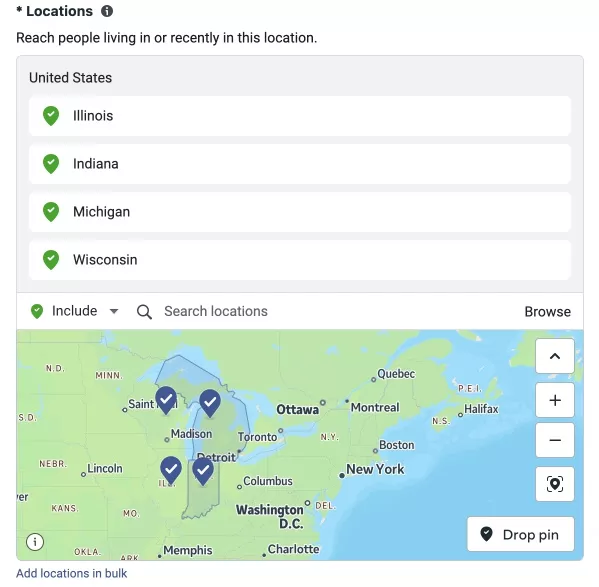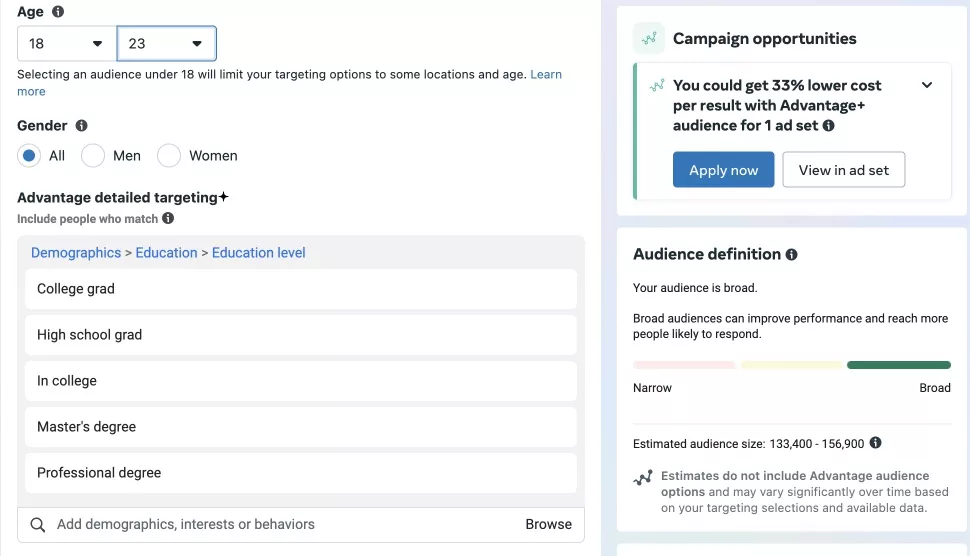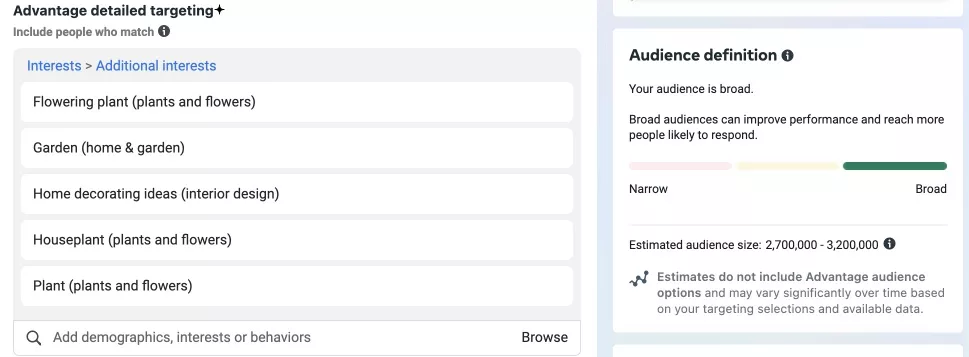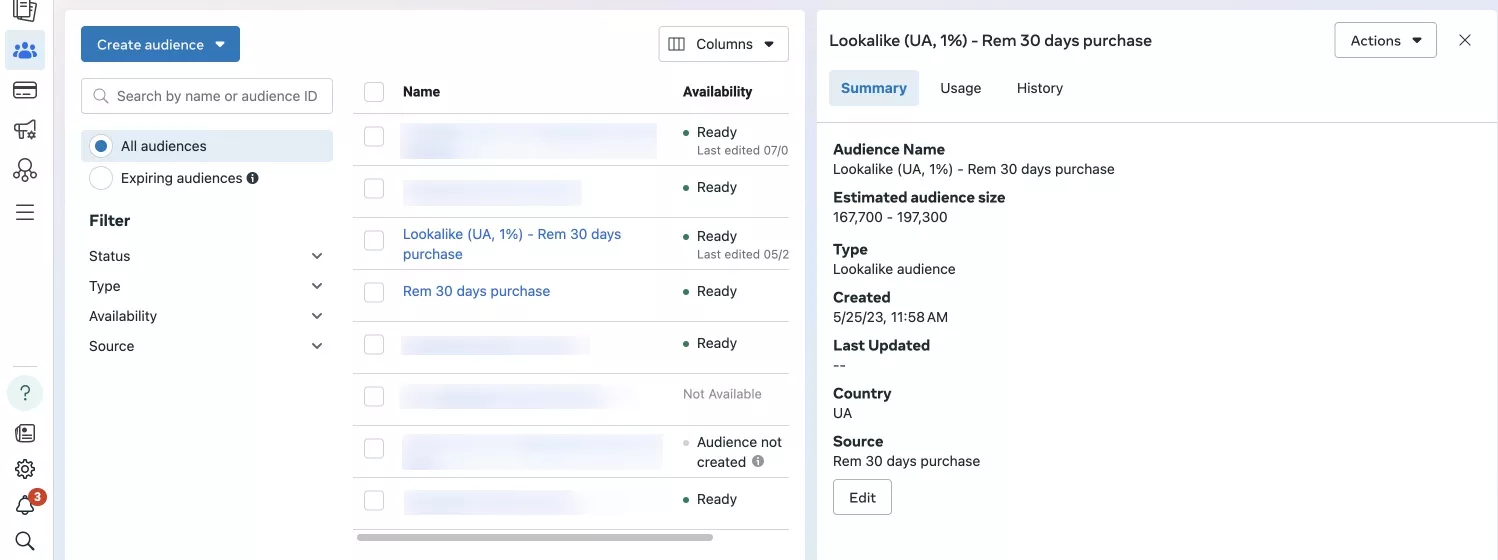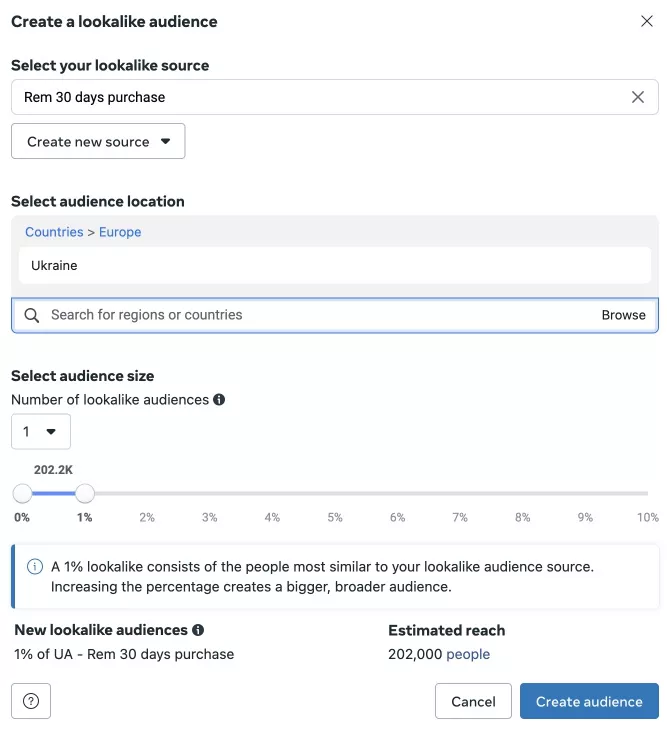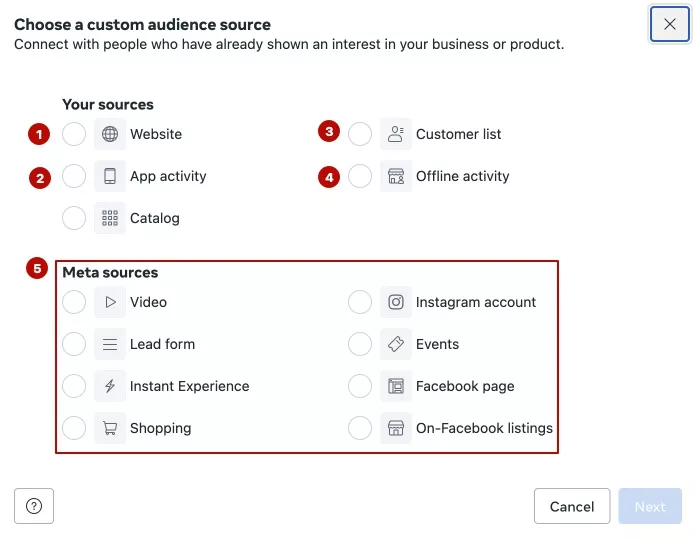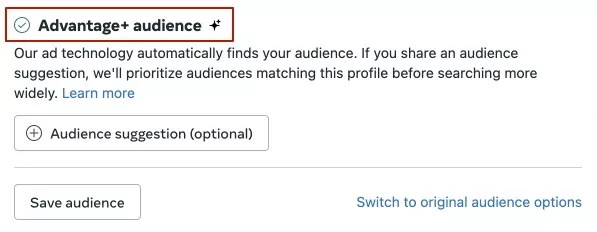How to Set Up Targeting for Instagram and Facebook Ads: A Step-by-Step Guide
Have you ever created the perfect ad, only to find the campaign results disappointing? Are you spending your advertising budget but not getting the response you want from your audience? Without proper targeting, even the most creative ads will go unnoticed.
In this article, I’m sharing a detailed guide with examples to help you optimize your targeting so that your Facebook and Instagram ads hit the target and produce tangible results.
Step 1: Create a customer profile.
Before you dive into customization, it is important to define your target audience and create a detailed profile of your ideal customer. Answer the following questions:
- Who are your potential customers?
- Where do they live?
- How old are they?
- What are their interests?
For example, if you run a fitness center in Texas and are planning to start a women's TRX group, your target audience is mainly women aged 25-35 who live in the city, are interested in sports, and lead an active lifestyle.
At Netpeak, we use a comprehensive approach to data collection to better understand our clients' target audience and develop an effective targeting strategy. Here’s what we do:
- Conduct in-depth interviews with representatives of the business we are promoting.
- Analyze the existing customer base to identify common characteristics and behavioral patterns.
- Study competitors and their audiences.
- Research industry trends.
- Use social media analysis tools to identify audience interests.
- Test different audience segments to optimize targeting.
Step 2: Choose the best targeting option.
Meta has powerful targeting tools, but using them effectively requires a deep understanding and the right approach.
Targeting for all your Instagram and Facebook ads is set up in a single Meta account, allowing you to centrally manage ads in all available formats across both social networks.
The platform offers multiple targeting options:
- General audience targeting
- Detailed targeting
- Lookalike (LAL) audience targeting
- Custom audience targeting
- Advantage+ audience targeting
Each of these has its benefits and significant potential, but their effectiveness can vary depending on your industry and business goals.
Let's take a closer look at these options and when to best use them.
General audience targeting
An advertising strategy that minimally restricts audience parameters without additional interest or behavioral restrictions.
By giving the ad platform more freedom to optimize ad impressions, this approach allows you to reach many users.
Even when using broad targeting, it is important to define basic audience parameters, such as location, age, and gender. This is recommended so that ads will not be shown in irrelevant regions or to inappropriate audiences.
Location plays a key role because it helps fine-tune the geography of ad display according to a business's specific needs.
Let's look at two scenarios.
Scenario 1: You own an offline women's clothing store. To maximize the effectiveness of local marketing, you can focus your advertising on the female audience in the region where your store is located.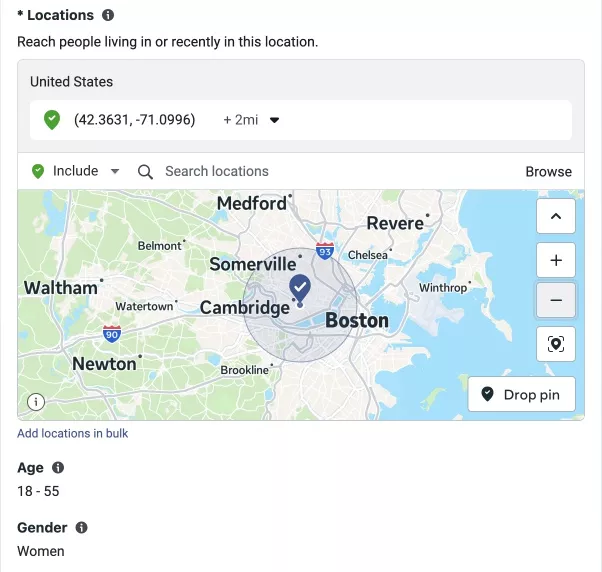

Projected results based on selected targeting parameters
Take a look at the estimated audience size, the projected reach, and the number of clicks that are displayed. This data is preliminary, but it will help you evaluate whether the campaign settings meet your expectations during the planning stage.
Scenario 2: Your business has both offline and online stores that ship to specific regions. In this case, you can expand the targeting location to reach potential customers in all regions where you ship products.
Example of advanced geotargeting
Broad targeting combined with precise geotargeting and selection of age and gender characteristics provides a flexible strategy that easily adapts to different business models and increases audience reach.
Detailed targeting
This strategy helps you accurately identify your target audience using Meta's rich dataset.
We have prepared an article on how to get the most out of your campaign using advanced audience settings.
You can use detailed targeting options to target your ads based on specific user characteristics.
Demographics
This option is necessary for setting up ads that take into account factors such as education, marital status, occupation, or even significant life events of your potential customers.
For example, the owner of a business targeting college students can target not only by age (18-23) but also by education level. This approach helps your ads reach those most likely to be interested in your products.
In addition, if you have a store located on or near a campus, you can target students of that university. This ensures high brand awareness and audience loyalty.
Interests
This option allows you to focus on users with specific interests, such as yoga, science fiction, business, or even parenting.
Imagine you own a houseplant store. With interest-based targeting, you can target users who are interested in flowers, gardening, or home decor. This will help you reach an audience with a high potential interest in your products.
Behaviors
This factor takes into account user actions on the network.
For example, it makes sense for a travel agency owner to target people who travel frequently.
Meta had a detailed targeting feature that allowed advertisers to exclude certain user groups from ad campaigns based on their interests, demographics, and behavior.
However, campaigns with deep targeting exclusions ran only until January 31, 2025. Since then, Meta has stopped serving ads with such exclusions altogether.
Lookalike (LAL) audience targeting
Lookalike audiences (LAL) allow you to expand your advertising reach by attracting new potential users who share similar characteristics with your existing customers.
This feature analyzes data from regular customers, newsletter subscribers, and website visitors who have provided their contact information. It then uses this information to find users with similar characteristics.
You can create a lookalike audience using a database of phone numbers of customers who have made a purchase on your site within the last month.
Example of LAL audience settings based on a client user base
Quality is more important than quantity. Meta recommends using a starting audience of between 1,000 and 5,000 people. You can also combine multiple similar audiences into one ad group to expand your reach.
When creating an audience, you can set the similarity percentage from 1% to 10%, with 1% being the most similar audience.
The higher the percentage, the broader and less similar the audience will be.
Although Meta offers a wide range, in our agency's practice, we have not encountered targeting audiences with less than 4% similarity.
Most importantly, the LAL audience does not include people from your original audience. In other words, you are always targeting new potential leads, which is especially useful for scaling your business. Here's an in-depth article on audience selection and targeting parameters on Facebook.
Custom audience targeting
These are groups of users who have already interacted with your business. Targeting these audiences is especially effective for re-engaging customers.
You can target your ads to:
- Website visitors
- Mobile app users
- Email subscribers
- Customers from your CRM system
- In-store shoppers
You can also fine-tune your audience by adding or excluding users based on their actions.
Benefits of using custom audiences:
- Get better quality leads at a lower cost by re-engaging interested users who haven't taken the desired action yet.
For example, an online furniture store creates an audience of visitors who have viewed specific products but have not completed their order. By targeting this audience with a special offer, the store increases conversions and reduces the cost per click.
- Bring high-quality traffic to the site.
For example, an education platform uses a custom audience created from email subscribers who have not visited the site in a month. Ads announcing new courses will grab their attention and bring them back to the site, increasing the likelihood of conversion.
- Drive more app installs.
For example, a fitness app creates an audience of users who downloaded the free version but did not upgrade to a paid subscription. Targeted ads offering a trial period for the premium version will increase the number of upgrades to the full version of the app.
Types of Facebook custom audiences
Meta has five main types of custom audiences for advertisers. Let's take a look at each one.
Website custom audiences
This parameter allows you to group visitors according to their actions on the website. To select this option, you first need to set up Facebook Pixel on your site.
For example, an online furniture store creates a custom audience based on visitors who viewed the section on sofas but did not place an order. In this case, it makes sense to target this audience with a special offer on sofas, which significantly increases the chances of conversion.
Customer list custom audiences
These audiences are based on users who have already interacted with your business, such as newsletter subscribers or users from your CRM system. A list of data in CSV format can be downloaded when you create an audience in your Meta Ads account.
For example, an English language school exports a list of former students' email addresses from its CRM system and uploads it to Facebook. It can then run targeted ads for new courses to this audience. As they are already familiar with its services, they are more likely to be interested in its new offerings.
App activity custom audiences
This type of audience allows you to target users who have already installed the app. It is recommended for increasing engagement and promoting new features or updates.
For example, a mobile game developer creates a custom audience of players who haven't logged in to the game in a month. It then serves an ad announcing a new game feature to bring them back.
Offline activity custom audiences
Offline activity audiences are used to track offline purchases and other interactions with users. Data is refreshed every 180 days.
For example, to promote a new loyalty program, a supermarket chain creates an audience of customers who have made an in-store purchase in the past three months.
Engagement custom audiences
This audience is built from users who have interacted with your brand through multiple sources:
- Videos
- Lead forms
- Instant Experiences
- Purchases
- Instagram accounts
- Events
- Facebook pages
- On-Facebook listings
For example, for online courses, create an audience of users who have watched more than 50% of a promotional video about a new course. Then, target them with additional ads offering a discount.
Advantage+ audience targeting
This targeting option is an innovative automation tool from Meta that frees advertisers from having to identify their target audience. It uses artificial intelligence and performance data to automatically find the right audience for a business.
The system works based on machine learning and analyzes the following:
- Past conversions
- Meta Pixel data
- Interactions with previous ads
According to Meta's test results, Advantage+ audience improves the effectiveness of advertising campaigns, regardless of their goals:
- A reduction of 13% in median sales value through the product catalog.
- A reduction of 7% in median conversion value on a site.
- A reduction of 28% in average cost per click, lead, or landing page view.
Using Advantage+ helps you maximize the potential of AI to optimize your campaigns and is especially useful in the following situations:
- Product launches where you don't have a clear understanding of your target audience.
- Expanding into new markets where you don't have consumer behavior data.
- Seasonal campaigns to quickly adapt to changing audience interests during holiday or seasonal sales.
- Testing promising audience segments.
- When resources are limited, especially for small businesses and startups that don't have the time or expertise to fine-tune their targeting.
- For dynamic industries where consumer interests and behavior change rapidly (e.g., fashion or technology).
- To analyze large volumes of customer data for effective targeting.
Step 3: Evaluate your campaign performance.
Each campaign objective has its own set of key performance indicators (KPIs) that reflect how well you are achieving your goals. Interpreting these metrics correctly allows you to make timely adjustments and maximize the effectiveness of your advertising investments.
Now, let’s take a closer look at the metrics for two popular types of campaigns: sales and traffic.
Key metrics for campaigns with the sales objective
- The number of purchase conversions is the most important indicator of a campaign's success. It shows the number of times users completed the desired action. It is important to track not only the total number of conversions but also the dynamics of the change in this metric.
- Cost per conversion shows how much you are spending on a single purchase. It helps you understand if your advertising investment is paying off. This metric should be kept below the average order value.
- Return on ad spend (ROAS) is the ratio of advertising revenue to advertising cost. For instance, a ROAS of 3:1 means that for every dollar you spend, you receive three dollars in revenue. This is a key metric for measuring the effectiveness of e-commerce advertising campaigns.
- Conversion rate refers to the percentage of visitors who make a purchase. It is used to evaluate the effectiveness of the sales funnel. The average conversion rate for e-commerce is usually 1-2%, but it can vary significantly depending on the niche.
- Average order value (AOV) shows the average amount customers spend. Increasing the AOV is an effective way to improve campaign performance without increasing the number of orders.
- Share of advertising spend tracks the percentage of revenue that is spent on advertising. It allows you to evaluate the profitability of advertising investments: the lower the share of ad spend, the more effective the campaign.
Example of a monthly plan vs. actual report for two conversion campaigns
Key metrics for campaigns with the traffic objective
- The number of clicks is a direct indicator of how many people were interested enough in your offer to visit your website. It is important to correlate this with the quality of the traffic.
- Click-through rate (CTR) shows clickability, which is the ratio of the number of clicks on an ad to the number of impressions. A high CTR indicates that the ad is relevant to the target audience.
- Cost per click (CPC) shows how much you pay for each click and helps you evaluate the effectiveness of your cost per visitor. The goal is to optimize your campaigns to reduce CPC while maintaining traffic quality.
In addition, it is important to track the following metrics for all types of campaigns:
- Reach: The number of unique users that saw your ad.
- Frequency: The average number of ad views per user. The best frequency is 3–4 times.
- Cost: The total amount spent on an ad campaign.
Example of a monthly plan vs. an actual report for a traffic campaign
Conclusions
Effective targeting for Instagram and Facebook ads is a complex process that requires a deep understanding of your audience, the ability to use a variety of targeting tools, and ongoing analysis of results.
To ensure that your advertising investment is as effective as possible and that your ads are reaching the right audience, it is important to follow some key principles.
- Before launching an advertising campaign, create a detailed target customer profile. Identify your potential customers’ demographics, interests, and behaviors.
- When choosing the type of targeting, be sure to focus on your campaign goals and business specifics:
- Use broad targeting for scaling and testing.
- Use detailed targeting to reach your exact audience.
- Choose lookalike audiences to find users who are similar to your customers.
- Work with custom audiences for re-engagement.
- Test Advantage+ to automate the process of finding potential leads.
- Use key metrics to regularly analyze campaign performance. Then, respond to changes and make adjustments to maximize the effectiveness of your advertising investment.
- Don't limit yourself to one audience. Test different targeting options and combine them for the best results.
- Constantly update your campaigns to reflect changes in user behavior and market trends.
Related Articles
How to Set Up Consent Mode in GA4 on Your Website with Google Tag Manager
Let's explore how to properly integrate consent mode in GA4, configure it for effective data collection, and at the same time comply with GDPR and other legal regulations
Display Advertising Effectiveness Analysis: A Comprehensive Approach to Measuring Its Impact
In this article, I will explain why you shouldn’t underestimate display advertising and how to analyze its impact using Google Analytics 4
Generative Engine Optimization: What Businesses Get From Ranking in SearchGPT
Companies that master SearchGPT SEO and generative engine optimization will capture high-intent traffic from users seeking direct, authoritative answers

